The Lubrizol Corporation
Advanced Emulsifier Technology
For Renewable Resource-Based Metalworking Fluids
By Jennifer Ineman, Product Manager, Metal Processing, The Lubrizol Corporation | TLT CMF Plus November 2011
Renewable resource metalworking fluids are gaining more attention in the marketplace and for good reason. Metalworking fluid producers are looking for more effective technologies to increase productivity and reduce downtime – without increasing costs. Changing regulatory requirements are driving the development of products with reduced environmental impact. At the same time, increasing concerns about workers’ health and safety are putting pressure on the industry to develop better solutions.
Renewable resource products based on vegetable oils offer an effective alternative to traditional petroleum-based products.
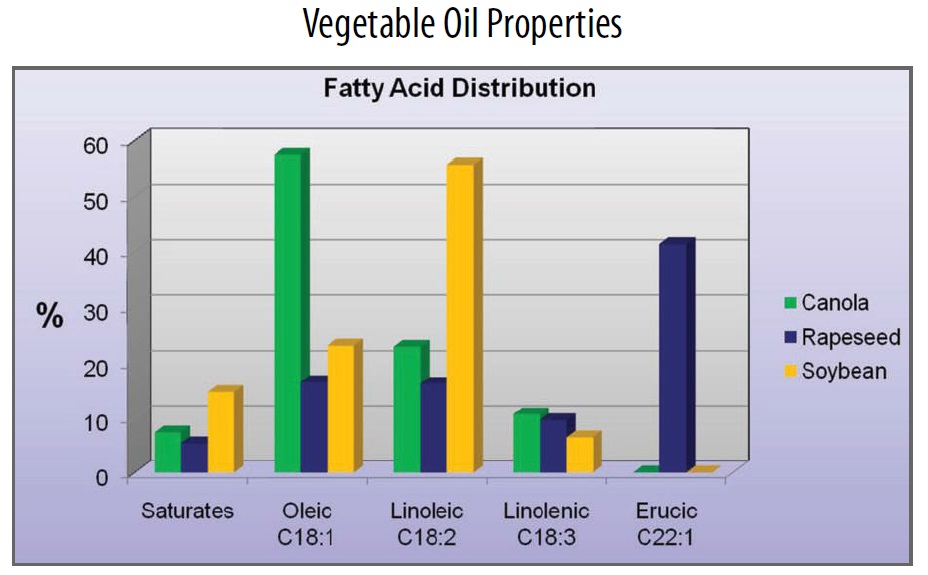 The above shows the relative composition of three common vegetable types considered for industrial applications: canola oil (common in North America); rapeseed oil (common in Europe); and soybean oil (common in North America).
The above shows the relative composition of three common vegetable types considered for industrial applications: canola oil (common in North America); rapeseed oil (common in Europe); and soybean oil (common in North America).
Market Drivers
The number one market driver for vegetable-oil technology?
It works. Polar vegetable oils are more effective lubricants than non-polar petroleum-based oils. And that can translate into improved part quality and surface finish, optimized tool life and potentially lower total fluid consumption. Because the technology is so effective, fewer chemicals are needed, reducing costs and the amount of fluid introduced into the environment, an important consideration in today’s market, where the push is on to create a more environmentally responsible metalworking fluid.
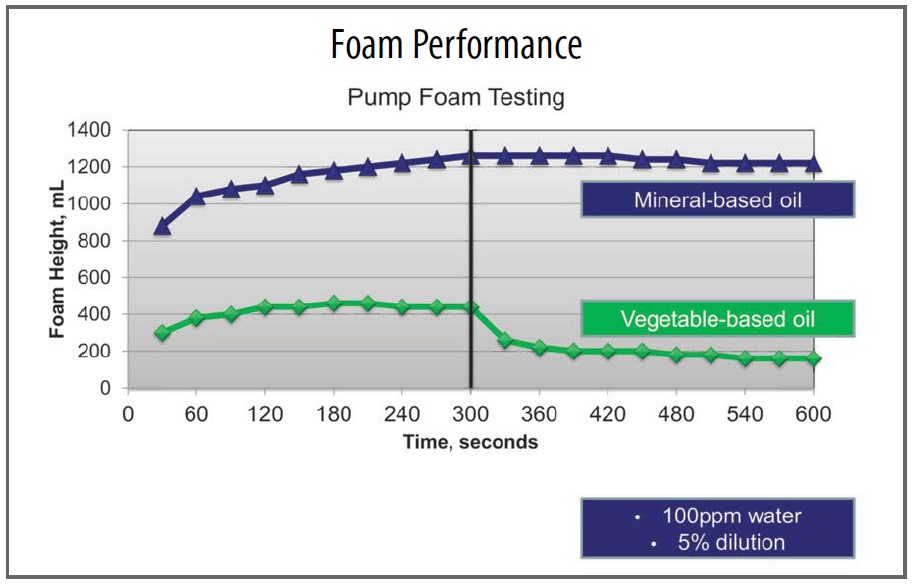 Tests formulations – with no added defoamer at 5% dilution in water – were run for five minutes in a recirculating pump with readings taken every 30 seconds. The pump was shut off after five minutes, but readings continued for the next five minutes. The low foam performance of the vegetable-based oil with the Lubrizol MC944V emulsifier is clearly shown.
Tests formulations – with no added defoamer at 5% dilution in water – were run for five minutes in a recirculating pump with readings taken every 30 seconds. The pump was shut off after five minutes, but readings continued for the next five minutes. The low foam performance of the vegetable-based oil with the Lubrizol MC944V emulsifier is clearly shown.
End users, such as workers’ unions and major manufacturers, perceive that renewable resource products offer an improved health, safety and environmental profile when compared with traditional petroleum options. Governmental preference programs, including tax incentives and preferred procurement programs, provide an additional incentive to move toward vegetable oil-based metalworking fluids.
A final potential market driver moving vegetable oils to the forefront is economics. Historically, refined vegetable oils have held substantially higher market price levels than their petroleum base stock counterparts; however, this price spread has narrowed in recent years. For the first time, the economics of switching to vegetable oils are workable.
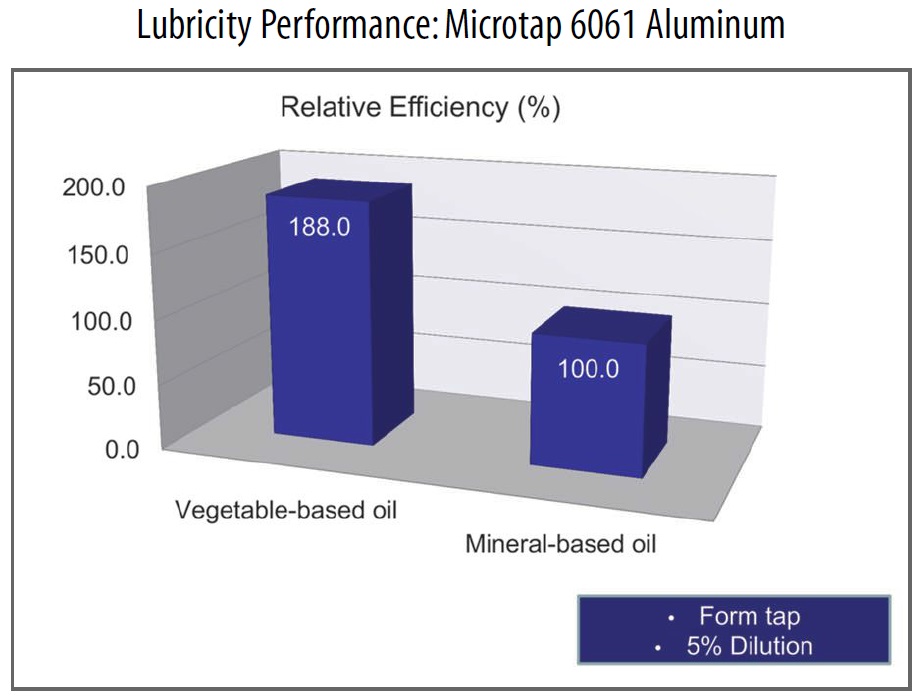 The vegetable oil formulated with Lubrizol MC944V delivered relative efficiency results 88% greater than the industry standard mineral-based fluid.
The vegetable oil formulated with Lubrizol MC944V delivered relative efficiency results 88% greater than the industry standard mineral-based fluid.
Market Challenges
While it is generally accepted that vegetable oils can outperform petroleum-based products in many areas, usage issues still remain that limit their application. First on the list: formulation challenges. Emulsification is more difficult with vegetable oils, which re quire a lower hydrophilic-lipophilic balance (HLB), resulting in the need for more and stronger emulsifiers. Natural oils are also more susceptible to hydrolysis, a condition that is accelerated by the alkaline nature of metalworking fluids. And during machining, it is inevitable that metal ions will be introduced to the fluid, which speeds up the process of oxidation. These issues are certainly not in surmountable and can be ad dressed with the appropriate fluid technologies.
Another challenge to additive suppliers is fluid formulators’ and end users’ high level of comfort with the status quo. The “if it’s not broken; don’t fix it” mentality comes into play here. End users have been working with petroleum-based fluids for quite some time, and they like and understand how these products operate. Add in the fact that, even with rising petroleum prices, these products are still relatively inexpensive, and it becomes clear that end users will need a compelling reason to make a change.
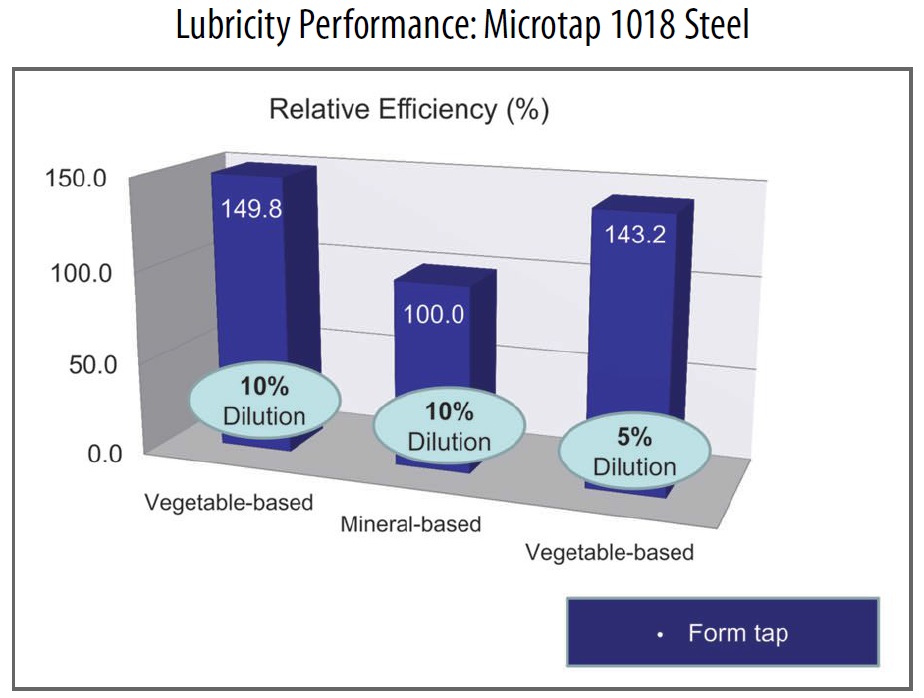 In this test, traditional mineral oils are diluted at 10%. The vegetable oil, diluted at 10%, delivered a 50% increase in efficiency over mineral-based oil. When diluted at 5% (not possible with mineral oils) the vegetable oils still delivered a 40% increase in efficiency. The result: vegetable-based oils deliver more parts at half the cost.
In this test, traditional mineral oils are diluted at 10%. The vegetable oil, diluted at 10%, delivered a 50% increase in efficiency over mineral-based oil. When diluted at 5% (not possible with mineral oils) the vegetable oils still delivered a 40% increase in efficiency. The result: vegetable-based oils deliver more parts at half the cost.
Not all Vegetable Oils are the Same
Although there will be variations between Group I, II or III basestocks, for the most part, naphthenic and paraffinic minerals are similar in nature. This is not true when it comes to vegetable oils. Canola oil, rapeseed oil and soybean oil will all behave differently. That’s why an understanding of the oil’s fatty acid composition and its likely impact on product stability and durability is essential.
In particular, the amount and type of unsaturated fatty acids (double bonds per carbon chain) is critical to the oxidative stability of the oil. Fully saturated carbon chains, like those found in petroleum-based oils, are ideal for oxidative stability, but the high degree of saturation can result in less fluidity, especially at lower temperatures. Canola oil, containing primarily monounsaturated fatty acid chains, is the easiest vegetable oil for formulation; rapeseed oil, with its longer carbon chain is slightly more challenging to emulsify; and soybean oil, with high levels of polyunsaturation, is best reserved for applications where expectations for long emulsion service life are low. Another option is the use of synthetic esters in place of the vegetable oils. These esters offer the formulator a more predictable, controlled structure. Oxidation can still be an issue, but emulsification is easier, and properly designed esters are the best option for avoiding polyunsaturation.
Current Vegetable Emulsifier Technologies
There are a number of drawbacks to currently available vegetable emulsifier technologies, starting with high treat rates – often in the 35 to 40 percent range – compared to 15 to 20 percent in a typical mineral oil formulation. As a result, formulations require twice as much of a more expensive product, and using more emulsifier can result in high foaming tendency. In addition, many emulsifier technologies have limited flexibility across different oils.
Attaining the desired pH range (9 to 9.5) is also a problem. Vegetable oils in general are not tolerant of alkalinity. Adding amine can cause them to become hazy and makes stable concentrates with good emulsification properties difficult to achieve. To address the alkalinity challenge, many manufacturers employ a “two-phase” system. One phase contains the oil/emulsifier combination, while another contains water-soluble alkaline builders so that oil and alkalinity can be kept separately. The two phases are both added to a working system, a difficult process that requires careful measurement and monitoring practices. The result is added complexity for the end user, increasing the possibility of operator error.
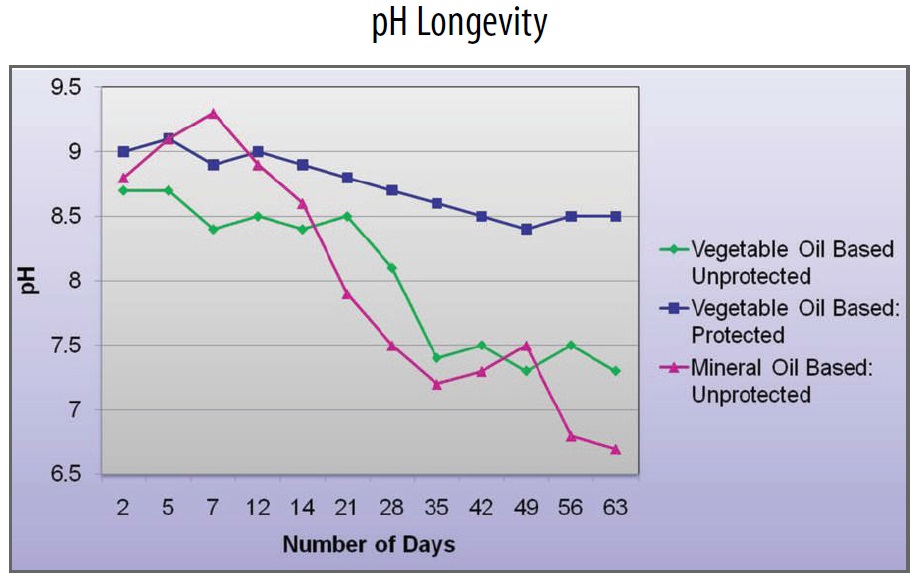 A modified ASTM E 2275 test was extended beyond the standard 12 day run to nine weeks. Unprotected, the vegetable oil and mineral oil acted in a similar way, with the mineral oil failing before the vegetable oil. The vegetable oil with the biocide was still in good working order after nine weeks.
A modified ASTM E 2275 test was extended beyond the standard 12 day run to nine weeks. Unprotected, the vegetable oil and mineral oil acted in a similar way, with the mineral oil failing before the vegetable oil. The vegetable oil with the biocide was still in good working order after nine weeks.
Introducing Lubrizol® MC944V
Lubrizol MC944V was designed to address many of the issues seen in currently available vegetable oil emulsifier technologies. In particular, this is a “one phase” product offering exceptional emulsification across a range of vegetable oils and esters, with finished products providing natural lubricity. Lubrizol MC944V is effective at low treat rates and capable of building alkalinity and pH levels for improved emulsion durability. It also produces inherently low foaming emulsions.
Testing Confirms Performance
To demonstrate the benefits of Lubrizol MC944V, Lubrizol conducted foam and lubricity performance testing. Formulations for both sets of tests consisted of 20% Lubrizol MC944V in high oleic canola and 18% industry standard package in naphthenic mineral-based oil.
Low Foaming: As fluids are forced into smaller sumps at higher speeds, foaming occurs and fluid can spill out of the sump. Excessive foaming can also have an impact on the lubricity of the formulation. Defoamers are usually recommended with metalworking fluid to combat the negative effects of foam, but they can be filtered out and need to be replenished. Because it is built from a low foaming ester, little or no defoamer is necessary in products formulated with Lubrizol’s MC944V emulsifier.
Lubricity: The lubricity of the vegetable oil formulated with Lubrizol MC944V was measured against the standard mineral-based oils. Microtap tests in aluminum and steel, run on a customized program, demonstrate the clear advantages of vegetable-based metalworking fluids.
Biological Resistance: An industry perception exists that vegetable oil-based emulsion products are inherently more subject to attack by bacteria and fungus than comparable petroleum oil products. In reality, laboratory testing has shown that vegetable emulsion products built from Lubrizol MC944V show a similar degree of attack and degradation from microorganisms as a petroleum-based product, when no biocide is incorporated. When an appropriate biocide is used, the vegetable oil emulsion shows extended protection from microbial growth and fluid degradation.
Addressing the Needs of the Marketplace
Lubrizol MC944V was designed in response to the market demand for renew able resource metalworking fluids. Tests prove that vegetable oil emulsions can be technically and economically viable. Based on a unique combination of emulsifier chemistries, MC944V addresses the specific challenges of the end market, providing exceptional emulsification in a wide range of vegetable oils and esters.